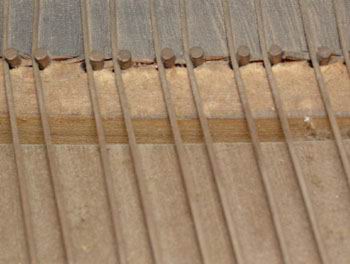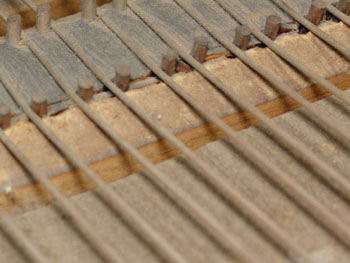New Haven Showroom
& Gallery 963
(203)785-8780
We now offer climate controlled STORAGE of pianos of all types. Call for competitive rates.
Complete refinishing, rebuilding and sales of vintage pianos in all categories.
More Used Piano Questions?
Brent Evans has set up a new consultation service to help you in purchasing a good piano.
How to hunt for a good used piano
You won't be able to tell how good a piano is by just looking at it. You have to look inside and you have to listen to it as well. Before you go to look at a used piano, wear clothes you can afford to get dirty. Bring a note pad, pen and bring a flashlight, no matter what time of day it is. Since people generally don't vacuum or dust the insides of their pianos, also bring a small width, soft paint brush to sweep dust off of a label or the bridges of the piano to inspect for small cracks next to the bridge pins.
-
What to check for:
- Start at the left of the keyboard and play each note, including the black keys, to see if each key works. As you do this listen for any buzzing or clicking sounds with any of the keys and make a note of it.
- Make a note of the piano maker. The name will be on the front of the piano or inside on the plate. Also, look for a 5 or 6 digit serial number usually stamped somewhere on the cast iron plate.
- Check all of the tuning pins to see if they have been set into the pinblock or not.
- Check the bass and treble bridges for cracks along the bridge pin lines. ( See pictures directly above.)
- If you are looking at a grand piano, get under the piano on your back and with the flash light check the soundboard for any visible cracks. Apply modest pressure with your thumb against the soundboard near each rib to check if the it has come unglued from the rib. If it does move this may result in annoying buzzing sounds whenever the piano is played so some repair work will be needed.
- If its an upright, start by carefully removing the bottom cover to look inside at some of the soundboard and carefully inspect the bass bridge for small cracks. You will need to use your flashlight for this.
- Lift the top lid of the piano and play each note, one at a time, while looking at the hammers hit the strings. Look for wobbly hammers and listen for any clicking sounds. Make notes of everything you find.

In this picture you see a section of tuning pins that show several problems. The front pin and the one directly behind it have been set into the pinblock as far as possible; you'll notice that the string coil is all the way against the plate. If the piano sounds horribly out of tune it probably
means the pins can no longer hold the string in tune. You can also see a water stain, probably from an over-watered plant, in the upper right corner of the picture. There is also rust visible on the pins, the strings and the string coils. This condition obviously will lead to string breakage.
This piano is in our shop for a complete internal restoration.

In this picture you see a newly installed set of tuning pins, set at the proper height. If done properly this piano can be reliably tuned for another 50 years or so.

In this picture you see a section of a bass bridge in a typical baby grand piano circa 1931. Each string has about 170 pounds of pressure on it. When a bridge cap starts to crack, it's impossible to tell how long it will be before you start to hear buzzing sounds. At this point tension on the
string cannot be maintained, creating a huge variable which makes the piano un-tuneable.

This picture shows a bridge cap that has gone so far that the pins on the right have lost all side-bearing with the strings. This piano needs to be rebuilt. A competent technician can tell you if the piano is worth repairing at that point. Keep in mind that if the case looks good, is in good
repair and the piano is of a major manufacturer, it may have a high market value and be worth the investment to have it rebuilt.
If you are considering the piano you are looking at, as a potentially good buy, you can the call me or your own qualified piano technician. Have your notes in hand and your technician can help you determine what to pay for the piano if anything at all.
If there are too many unanswered questions but you still feel the piano might be a good purchase, you can arrange and pay for a technician to do an onsite inspection. The average price for an onsite inspection is $50 to $100 (plus travel time if the piano is out of the immediate area).
Read about rebuilding and restoring pianos.
What we do.
evanspiano.com
Workshop & Showroom34 Front Street, Building 2, 4th Floor, Indian Orchard, MA
New Haven Showroom & Gallery 963
963 State Street, New Haven 06511
(203) 785-8780
(Visits by Appointment)
email:
Copyright © 2004-2012 Brenton Evans Piano Restoration. All Rights Reserved
Privacy Policy and Legal Statement
